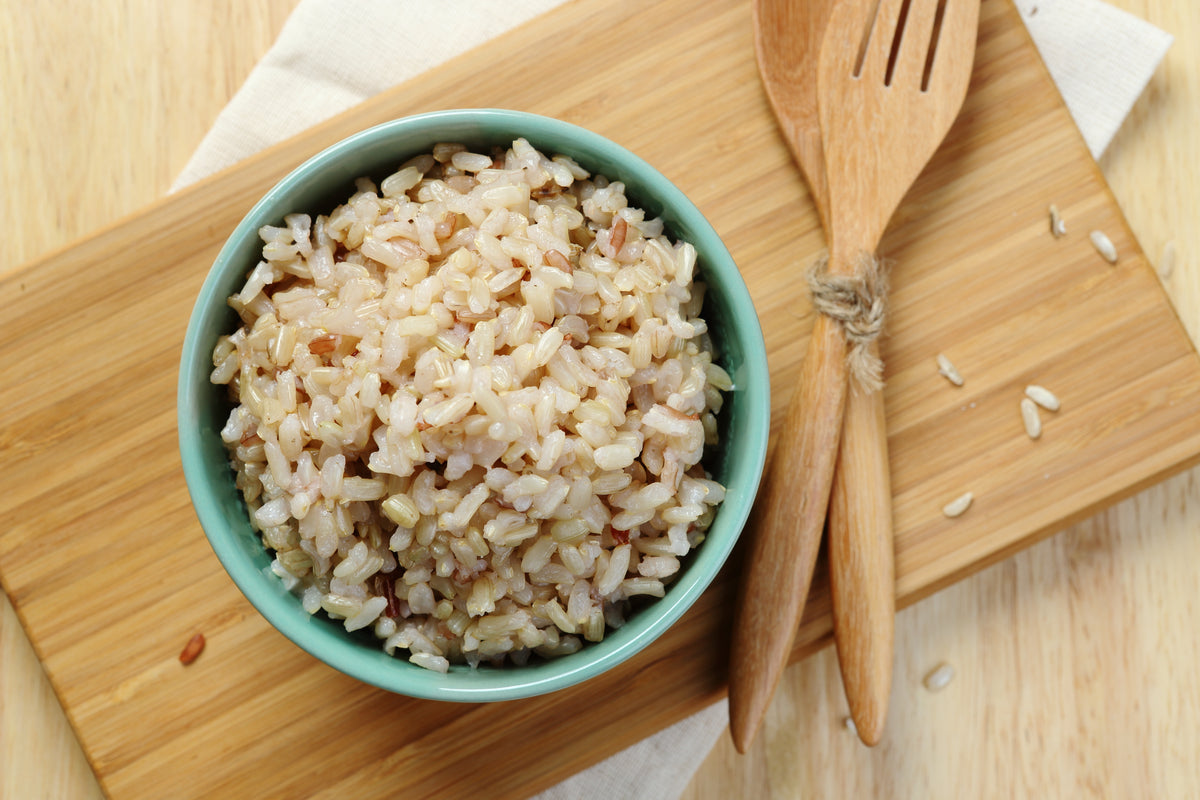
Quick Synopsis
While grain-free may be trending, your body needs the nutrients and fiber found in whole grains to keep your body running smoothly, from your digestion to your blood sugar to your heart health. Discover how to cook healthy whole grains perfectly, every time.
The Full Story
Did you know plant-based nutrition experts suggest getting 75-80% of your calories from whole carbohydrates, like whole grains? For the carb-phobic, this can be jarring! Won’t eating this many grains lead to weight gain and unregulated blood sugars? Not when you’re eating whole grains!
Whole grains vs. refined grains
Whole grains (and whole carbohydrates, in general), are a whole different beast than the refined versions we see in unhealthy processed foods.
What’s the difference between the two? Fiber and nutrients, baby! Unlike refined grains (white bread, white rice, cookies, crackers, white pasta, etc.), are stripped of these. Whole grains like wheat, corn, brown rice, oats, barley, bulgur, quinoa, and farro are unprocessed so their fiber and nutrients are still intact. This is a big deal, especially the fiber piece.
Fiber adds bulk to our diet keeping us full longer and regulating our blood sugar. A high fiber diet aids in healthy weight loss, lowers cholesterol, keeps bowels regular, and reduces the risk of serious chronic illness like type 2 diabetes, heart disease, and certain cancers.
But most folks aren’t eating enough fiber-rich foods like whole grains; some studies suggest 97% of Americans are fiber-deficient! Let’s fix that...by cooking up some delicious grains.
How to cook perfect whole grains every time
Have a few meals with crunchy brown rice turned you off from whole grains altogether? We get it! But we’re here to tell you whole grains aren’t just nutritious, they’re delicious, too...when cooked right! We’ve outlined easy peasy cooking instructions for some of our favorite whole grains.
1. Brown Rice
Brown rice is white rice before it’s processed, so it’s a great swap for any recipe that calls for white rice. Brown rice has a fluffy texture and a mild nutty flavor. It’s also high in nutrients like fiber, protein, potassium, and manganese (important for bone development and blood sugar regulation).
How to cook brown rice:
- Give your brown rice a quick rinse before cooking to rinse away grit from production. Plus, it gets rid of the surface starch, which when left on your rice can lead to a gummy pot of grains that no one wants! (Some folks argue you need to soak your rice but a rinse is fine!)
- Add 2 cups of water and 1 cup of brown rice to a pot and bring to a boil on the stovetop.
- Once boiling, cover and reduce heat to a simmer for 40 minutes, until water is absorbed.
- No peeking! The more often you remove the lid while cooking, the more likely it is you’ll be suffering through crunchy rice at dinner.
- Yields 4 cups of cooked brown rice.
Our favorite ways to enjoy brown rice:
- With MamaSezz Moroccan Stew
- Vegetable Not-Fried Rice
- Stuffed in bell peppers with black beans and hot sauce
2. Bulgur
A variation of whole wheat, bulgur cooks quickly so it’s perfect for the busy grain eater.
How to cook bulgur:
- Bring 2 cups of water and 1 cup of bulgur to a boil on the stovetop.
- Reduce heat to simmer for 10-12 minutes.
- Yields 3 cups of cooked bulgur.
Our favorite ways to enjoy bulgur:
- In tabouli
- In vegan chili (it adds bulk!)
- Tossed in a spinach salad
3. Farro
Chewy, nutty, and a little sweet, farro is an ancient grain with lots of fiber and protein so fuel up at lunchtime!
How to cook farro:
- Bring 3 cups of water and 1 cup of farro to a boil on the stovetop.
- Reduce heat to simmer and cover for 30 minutes.
- Yields 3 cups of cooked farro.
Our favorite ways to enjoy farro:
- In a burrito bowl (in place of rice).
- In just about any salad
4. Oats
Stay full (and happy) all morning long when you start your day with oats. Shy away from pre-packaged and flavored varieties as they tend to be high in processed sugar. Go for rolled oats (also called old-fashioned oats) or steel cut instead. They’re cheap and super easy to prepare.
How to cook rolled oats:
- Bring 2 cups of water (or unsweetened non-dairy milk) to a boil on the stovetop.
- Stir in 1 a cup of oats and reduce to medium heat. Stir occasionally for 5 minutes.
- Remove from heat and cover for 3 minutes before enjoying.
- Yields 2 cups of cooked oats.
How to cook steel cut oats:
- Bring 3 cups of water to a boil.
- Stir in 1 cup of steel cut oats.
- Reduce heat to a simmer and cook (stirring occasionally) for 10-20 minutes.
- Remove from heat and cover for 3 minutes before enjoying.
- Yields 4 cups of cooked oats (steel cut oats cook longer and expand more than other types of oats).
Our favorite ways to enjoy oatmeal:
- With all-natural nut butter, berries, and walnuts.
- With pumpkin spice seasoning and bananas.
- With cinnamon and sliced apples.
5. Quinoa
Did you know quinoa’s actually a seed, not a grain? Technicalities aside, we’re going to keep this gluten-free option on the list because it’s a great source of plant-based protein, calcium, and vitamin E. Not to mention it’s mild flavor means it works well with all sorts of plant-based recipes!
How to cook quinoa:
- Rinse and drain quinoa (in a sieve, not a colander -- dry quinoa seeds are small!)
- Bring 2 cups of water to a boil.
- Stir in 1 cup of quinoa.
- Reduce heat to a simmer, cover, and cook for 15 minutes.
- Remove from heat (still covered) for 5 minutes then fluff with a fork!
- Yields 3 cups cooked
Our favorite ways to enjoy quinoa:
- With MamaSezz Hungarian Mushroom Soup.
- In a vegan breakfast bowl!
- As a hearty salad bowl.
- Our ready to heat-and-eat Quinoa Stack (no cooking required - we’ve done that part for ya!).
Key takeaways
Look at you, discovering new healthy foods! To sum it up:
- Whole grains are an important part of your healthy whole food plant-based diet because they’re rich in nutrients and fiber.
- Fiber is great for our digestive health, heart health, cholesterol levels, blood sugar, and maintaining a healthy weight.
- All you really need to cook grains is your grain of choice, a pot, a stovetop, and some water.
- Cook times vary for each grain!
